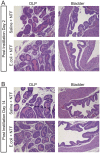Prostatic inflammation induces urinary frequency in adult mice
- PMID: 25647072
- PMCID: PMC4315606
- DOI: 10.1371/journal.pone.0116827
Prostatic inflammation induces urinary frequency in adult mice
Abstract
Lower urinary tract symptoms (LUTS) including urinary frequency and nocturia are common in aging men. Recent studies have revealed a strong association of prostatic inflammation with LUTS. We developed an animal model of bacterial induced, isolated prostatic inflammation and examined the effect of prostatic inflammation on voiding behavior in adult C57BL/6J mice. Prostatic inflammation was induced by transurethral inoculation of uropathogenic E. coli-1677. Bacterial cystitis was prevented by continuous administration of nitrofurantoin. Hematoxylin and eosin (H&E) staining and bacterial culture were preformed to validate our animal model. Voiding behavior was examined by metabolic cage testing on post-instillation day 1 (PID 1), PID 4, PID 7 and PID 14 and both voiding frequency and volume per void were determined. Mice with prostatic inflammation showed significantly increased voiding frequency at PID 1, 7 and 14, and decreased volume per void at all time points, as compared to mice instilled with saline and receiving nitrofurantoin (NTF). Linked analysis of voiding frequency and voided volumes revealed an overwhelming preponderance of high frequency, low volume voiding in mice with prostatic inflammation. These observations suggest that prostatic inflammation may be causal for symptoms of urinary frequency and nocturia.
Conflict of interest statement
Figures





Similar articles
-
A uropathogenic E. coli UTI89 model of prostatic inflammation and collagen accumulation for use in studying aberrant collagen production in the prostate.Am J Physiol Renal Physiol. 2021 Jan 1;320(1):F31-F46. doi: 10.1152/ajprenal.00431.2020. Epub 2020 Nov 2. Am J Physiol Renal Physiol. 2021. PMID: 33135480 Free PMC article.
-
The evaluation of nocturia in patients with lower urinary tract symptoms suggestive of benign prostatic hyperplasia and the analysis of the curative effect after medical or placebo therapy for nocturia: a randomized placebo-controlled study.BMC Urol. 2018 Dec 13;18(1):115. doi: 10.1186/s12894-018-0426-4. BMC Urol. 2018. PMID: 30545338 Free PMC article. Clinical Trial.
-
Long-lasting bladder overactivity and bladder afferent hyperexcitability in rats with chemically-induced prostatic inflammation.Prostate. 2019 Jun;79(8):872-879. doi: 10.1002/pros.23794. Epub 2019 Mar 22. Prostate. 2019. PMID: 30900300 Free PMC article.
-
Convective Water Vapor Energy for Lower Urinary Tract Symptoms/Benign Prostatic Hyperplasia.Urol Clin North Am. 2016 Aug;43(3):371-5. doi: 10.1016/j.ucl.2016.04.005. Urol Clin North Am. 2016. PMID: 27476129 Review.
-
EAU Guidelines on the Assessment of Non-neurogenic Male Lower Urinary Tract Symptoms including Benign Prostatic Obstruction.Eur Urol. 2015 Jun;67(6):1099-1109. doi: 10.1016/j.eururo.2014.12.038. Epub 2015 Jan 19. Eur Urol. 2015. PMID: 25613154 Review.
Cited by
-
Sex differences in IL-17 contribute to chronicity in male versus female urinary tract infection.JCI Insight. 2019 May 30;5(13):e122998. doi: 10.1172/jci.insight.122998. JCI Insight. 2019. PMID: 31145099 Free PMC article.
-
Differential neurodegenerative phenotypes are associated with heterogeneous voiding dysfunction in a coronavirus-induced model of multiple sclerosis.Sci Rep. 2019 Jul 26;9(1):10869. doi: 10.1038/s41598-019-47407-x. Sci Rep. 2019. PMID: 31350464 Free PMC article.
-
Repeated Low-Dose Acrolein Triggers Irreversible Lamina Propria Edema in Urinary Bladder, Transient Voiding Behavior and Widening of Eyes to Mechanical Stimuli.Cells. 2021 Dec 9;10(12):3477. doi: 10.3390/cells10123477. Cells. 2021. PMID: 34943985 Free PMC article.
-
Effects of Estrogen Receptor β Stimulation in a Rat Model of Non-Bacterial Prostatic Inflammation.Prostate. 2017 May;77(7):803-811. doi: 10.1002/pros.23320. Epub 2017 Feb 9. Prostate. 2017. PMID: 28181685 Free PMC article.
-
Metabolic syndrome, inflammation and lower urinary tract symptoms: possible translational links.Prostate Cancer Prostatic Dis. 2016 Mar;19(1):7-13. doi: 10.1038/pcan.2015.43. Epub 2015 Sep 22. Prostate Cancer Prostatic Dis. 2016. PMID: 26391088 Free PMC article.
References
Publication types
MeSH terms
Grants and funding
LinkOut - more resources
Full Text Sources
Other Literature Sources
Medical

